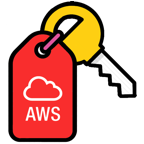Ecosyste.ms: Awesome
An open API service indexing awesome lists of open source software.
https://github.com/tristanmorgan/awskeyring
Manage AWS creds and tokens in your macOS keychain with autocomplete.
https://github.com/tristanmorgan/awskeyring
autocomplete aws aws-console gem keychain macos ruby temporary-credentials
Last synced: 6 days ago
JSON representation
Manage AWS creds and tokens in your macOS keychain with autocomplete.
- Host: GitHub
- URL: https://github.com/tristanmorgan/awskeyring
- Owner: tristanmorgan
- License: mit
- Created: 2017-12-22T01:53:39.000Z (about 7 years ago)
- Default Branch: main
- Last Pushed: 2025-02-03T00:34:03.000Z (17 days ago)
- Last Synced: 2025-02-03T01:25:56.273Z (17 days ago)
- Topics: autocomplete, aws, aws-console, gem, keychain, macos, ruby, temporary-credentials
- Language: Ruby
- Homepage: https://github.com/tristanmorgan/awskeyring/wiki
- Size: 481 KB
- Stars: 25
- Watchers: 18
- Forks: 1
- Open Issues: 0
-
Metadata Files:
- Readme: README.md
- Changelog: CHANGELOG.md
- Contributing: CONTRIBUTING.md
- License: LICENSE.txt
- Code of conduct: CODE_OF_CONDUCT.md
- Codeowners: .github/CODEOWNERS
- Security: SECURITY.md
Awesome Lists containing this project
README
# Awskeyring

* 
* [](https://badge.fury.io/rb/awskeyring)
* [](https://opensource.org/licenses/MIT)
* [](https://rubygems.org/gems/awskeyring)
* [](https://rubygems.org/gems/awskeyring)
* [](https://www.rubydoc.info/gems/awskeyring)
Awskeyring is a small tool to manage AWS account keys in the macOS Keychain. It has
grown to incorporate a lot of [features](https://github.com/tristanmorgan/awskeyring/wiki/Awskeyring-features).
## Project Status
Awskeyring is a fairly mature project so it it doesn't see frequent updates but is still being maintained.
It is tested against the version of Ruby that is shipped with the latest version of macOS, but that ruby version is dated.
## Motivation
The motivation of this application is to provide a local secure store of AWS
credentials using specifically in the macOS Keychain, to have them easily accessed
from the Terminal, and to provide useful functions like assuming roles and opening
the AWS Console from the cli.
For Enterprise environments there are better suited tools to use
like [HashiCorp Vault](https://vaultproject.io/).
## Installation
Install it with:
$ gem install awskeyring --user-install
or via [homebrew gem](https://github.com/sportngin/brew-gem):
$ brew gem install awskeyring
## Wiki
Please see the [Wiki](https://github.com/tristanmorgan/awskeyring/wiki) for full usage instructions and tips.
## Quick start
First you need to initialise your keychain to hold your AWS credentials.
$ awskeyring initialise
Then add your keys to it.
$ awskeyring add personal-aws
Now your keys are stored safely in the macOS keychain. To print environment variables run...
$ awskeyring env personal-aws
Alternatively you can create a profile using the credential_process config variable. See the
[AWS CLI Config docs](https://docs.aws.amazon.com/cli/latest/topic/config-vars.html#cli-aws-help-config-vars) for
more details on this config option.
[profile personal]
region = us-west-1
credential_process = /usr/local/bin/awskeyring json personal-aws
## Usage
The CLI is using [Thor](http://whatisthor.com) with help provided interactively.
Awskeyring commands:
awskeyring --version, -v # Prints the version
awskeyring add ACCOUNT # Adds an ACCOUNT to the keyring
awskeyring add-role ROLE # Adds a ROLE to the keyring
awskeyring console ACCOUNT # Open the AWS Console for the ACCOUNT
awskeyring env ACCOUNT # Outputs bourne shell environment exports for an ACCOUNT
awskeyring exec ACCOUNT command... # Execute a COMMAND with the environment set for an ACCOUNT
awskeyring help [COMMAND] # Describe available commands or one specific command
awskeyring import ACCOUNT # Import an ACCOUNT to the keyring from ~/.aws/credentials
awskeyring initialise # Initialises a new KEYCHAIN
awskeyring json ACCOUNT # Outputs AWS CLI compatible JSON for an ACCOUNT
awskeyring list # Prints a list of accounts in the keyring
awskeyring list-role # Prints a list of roles in the keyring
awskeyring remove ACCOUNT # Removes an ACCOUNT from the keyring
awskeyring remove-role ROLE # Removes a ROLE from the keyring
awskeyring remove-token ACCOUNT # Removes a token for ACCOUNT from the keyring
awskeyring rotate ACCOUNT # Rotate access keys for an ACCOUNT
awskeyring token ACCOUNT [ROLE] [CODE] # Create an STS Token from a ROLE or an mfa CODE
awskeyring update ACCOUNT # Updates an ACCOUNT in the keyring
and autocomplete that can be installed with:
$ complete -C /usr/local/bin/awskeyring awskeyring
There are also short forms of most commands if you prefer:
$ awskeyring ls
To set your environment easily the following bash function helps:
awsenv() { eval "$(awskeyring env ${@:-$AWS_ACCOUNT_NAME})"; }
## Development
After checking out the repo, run `bundle update` to install dependencies. Then, run `bundle exec rake` to run the
tests. Run `bundle exec awskeyring` to use the gem in this directory, ignoring other installed copies of this gem.
Awskeyring is tested against the last two versions of Ruby shipped with macOS.
To install this gem onto your local machine, run `bundle exec rake install`.
## Security
If you believe you have found a security issue in Awskeyring, please responsibly disclose by contacting me at
[[email protected]](mailto:[email protected]). Awskeyring is a Ruby script and as such Ruby is whitelisted
to access your "awskeyring" keychain. Use a strong password and keep the unlock time short.
## Contributing
Bug reports and pull requests are welcome on GitHub at [https://github.com/tristanmorgan/awskeyring](https://github.com/tristanmorgan/awskeyring).
This project is intended to be a safe, welcoming space for collaboration, and contributors are expected to adhere to
the [Contributor Covenant](https://contributor-covenant.org) code of conduct.
### Contributors
* Tristan [tristanmorgan](https://github.com/tristanmorgan)
* Adam Sir [AzySir](https://github.com/AzySir)
* Vito Giarrusso [thtliife](https://github.com/thtliife)
## License
The gem is available as open source under the terms of the [MIT License](https://opensource.org/licenses/MIT).